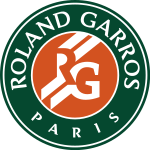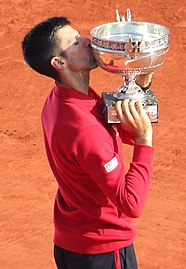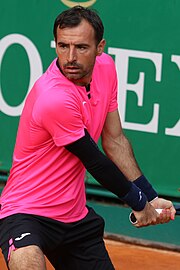
A | B | C | D | E | F | G | H | CH | I | J | K | L | M | N | O | P | Q | R | S | T | U | V | W | X | Y | Z | 0 | 1 | 2 | 3 | 4 | 5 | 6 | 7 | 8 | 9
 | |
| Official website | |
| Founded | 1891 |
|---|---|
| Editions | 123 (2024) 94 Grand Slam events (since 1925) |
| Location | Paris, XVIth arrondissement France |
| Venue | Stade Roland Garros (since 1928) Societé de Sport de Île de Puteaux, at Puteaux (1891–1894); Tennis Club de Paris, at Auteuil (1895–1908); Société Athlétique de la Villa Primrose at Bordeaux (1909); Croix-Catelan de Racing Club de France at the Bois de Boulogne (1910–1924, 1926); Stade Français at Saint-Cloud (1925, 1927) |
| Surface | Clay – outdoors[a] (1908–present) Sand – outdoors (1892–1907) Grass – outdoors (1891) |
| Prize money | €49,600,000 (2023)[1] |
| Men's | |
| Draw | S (128Q) / 64D (16Q)[b] |
| Current champions | Novak Djokovic (singles) Ivan Dodig Austin Krajicek (doubles) |
| Most singles titles | Rafael Nadal (14) |
| Most doubles titles | Roy Emerson (6) |
| Women's | |
| Draw | S (128Q) / 64D (16Q) |
| Current champions | Iga Świątek (singles) Hsieh Su-wei Wang Xinyu (doubles) |
| Most singles titles | Chris Evert (7) |
| Most doubles titles | Martina Navratilova (7) |
| Mixed doubles | |
| Draw | 32 |
| Current champions | Miyu Kato Tim Pütz |
| Most titles (male) | Ken Fletcher / Jean-Claude Barclay (3) |
| Most titles (female) | Margaret Court (4) |
| Grand Slam | |
| Last completed | |
| 2023 French Open | |
| Ongoing | |
| Women's pro tennis |
|---|
|
|
Roland-Garros[2] (French: [ʁɔlɑ̃ ɡaʁos]), colloquially referred to as the French Open[3] (French: Internationaux de France de tennis) in anglophone countries, is a major tennis tournament held over two weeks at the Stade Roland Garros in Paris, France, beginning in late May each year.[c] The tournament and venue are named after the French aviator Roland Garros.[4] Roland-Garros is the premier clay court championship in the world and the only Grand Slam tournament currently held on this surface. It is chronologically the second of the four annual Grand Slam tournaments,[5] occurring after the Australian Open and before Wimbledon and the US Open. Until 1975, Roland-Garros was the only major tournament not played on grass. Between the seven rounds needed for a championship, the clay surface characteristics (slower pace, higher bounce), and the best-of-five-set men's singles matches, Roland-Garros is widely regarded as the toughest and most physically demanding tournament in tennis.[6][7][8][9][10][11]
History
Officially named in French Internationaux de France de Tennis ("French Internationals of Tennis" in English),[12][13] the tournament uses the name Roland-Garros internationally,[14] and it is usually called the French Open in English.[15] (The stadium and tournament are both hyphenated as Roland-Garros because French spelling rules dictate that in the name of a place or event named after a person, the elements of the name are joined with a hyphen.[16])
In 1891 the Championnat de France, which is commonly referred to in English as the French Championships, began. This was only open to tennis players who were members of French clubs. The first winner was H. Briggs, a Briton who resided in Paris and was a member of the Club Stade Français. In the final, he defeated P. Baigneres in straight sets.[17] The first women's singles tournament, with four entries, was held in 1897. The mixed doubles event was added in 1902 and the women's doubles in 1907. In the period of 1915–1919, no tournament was organized due to World War I. This tournament was played until 1924, using four venues:
- Societé de Sport de l'Île de Puteaux, in Puteaux, Île-de-France (next to the Seine river); played on the club's ten sand grounds laid out on a bed of rubble. 1891, 1893, 1894 (men's singles), 1895 (men's singles), 1897 (women's singles), 1902 (women's singles and mixed doubles), 1905 (women's singles and mixed doubles), 1907 (men's singles, women's singles, mixed doubles) editions.
- The Croix-Catelan of the Racing Club de France (club founded in 1882 which initially had two lawn-tennis courts with four more grass (pelouse) courts opened some years later, but due to the difficulty of maintenance, they were eventually transformed into clay courts) in the Bois de Boulogne, Paris. 1892, 1894 (men's doubles), 1895 (men's doubles), 1897 (women's singles), 1901 (men's doubles), 1903 (men's doubles and mixed doubles), 1904, 1907 (men's doubles), 1908, 1910–1914, 1920–1924 editions.
- Tennis Club de Paris (club founded in 1895 which initially had four indoor wood courts and five outdoor clay courts), at 71, Boulevard Exelmans in the Auteuil neighborhood, Paris. 1896, 1897 (men's singles), 1898, 1899, 1900, 1901 (men's and women's singles), 1902 (men's singles), 1903 (men's singles and women's singles), 1905 (men's singles) and 1906 editions.
- Société Athlétique de la Villa Primrose in Bordeaux, on clay. Only played in 1909.
In 1925, the French Championships became open to all amateurs internationally and was designated a major championship by the International Lawn Tennis Federation. It was held at the Stade Français in Saint-Cloud (site of the previous World Hard Court Championships) in 1925 and 1927, on clay courts. In 1926 the Croix-Catelan of the Racing Club de France hosted the event in Paris, site of the previous French club members only tournament, also on clay.
Another clay court tournament, called the World Hard Court Championships, is sometimes considered the true precursor to the modern French Open as it admitted international competitors. This was held at Stade Français in Saint-Cloud, from 1912 to 1914, 1920, 1921 and 1923, with the 1922 event held in Brussels, Belgium. Winners of this tournament included world No. 1s such as Tony Wilding from New Zealand (1913, 1914) and Bill Tilden from the US (1921). In 1924 there was no World Hard Court Championships due to tennis being played at the Paris Olympic Games.
After the Mousquetaires or Philadelphia Four (René Lacoste, Jean Borotra, Henri Cochet, and Jacques Brugnon) won the Davis Cup on American soil in 1927, the French decided to defend the cup in 1928 at a new tennis stadium at Porte d'Auteuil. The Stade de France had offered the tennis authorities three hectares of land with the condition that the new stadium must be named after the World War I aviator hero Roland Garros.[18] The new Stade de Roland Garros (whose central court was renamed Court Philippe Chatrier in 1988) hosted that Davis Cup challenge. On May 24, 1928, the French International Championships moved there, and the event has been held there ever since.[19]
During World War II, the Tournoi de France was not held in 1940 and from 1941 through 1945 it took place on the same grounds, but those events are not recognized by the French governing body, the Fédération Française de Tennis.[20] In 1946 and 1947, the French Championships were held after Wimbledon, making it the third Grand Slam event of the year. In 1968, the year of the French General Strike, the French Championships became the first Grand Slam tournament to go open, allowing both amateurs and professionals to compete.[19]
Since 1981, new prizes have been presented: the Prix Orange (for the player demonstrating the best sportsmanship and cooperative attitude with the press), the Prix Citron (for the player with the strongest character and personality) and the Prix Bourgeon (for the tennis player revelation of the year). In another novelty, since 2006 the tournament has begun on a Sunday, featuring 12 singles matches played on the three main courts. Additionally, on the eve of the tournament's opening, the traditional Benny Berthet exhibition day takes place, where the profits go to different charity associations. In March 2007, it was announced that the event would provide equal prize money for both men and women in all rounds for the first time.[21] In 2010, it was announced that the tournament was considering a move away from Roland Garros as part of a continuing rejuvenation.[22] Plans to renovate and expand Roland Garros have put aside any such consideration, and the tournament remains in its long time home.
The 2022 edition finally saw a new tiebreaker format.[23] If the deciding set is tied at six-all, the match is decided in a 10-point format. Should the tiebreaker game be tied at 9-all (or any tie hereafter), whoever scores two straight points wins.[24] The decision was made by the Grand Slam Board for all four Grand Slams "based on a strong desire to create greater consistency in the rules of the game at the grand slams, and thus enhance the experience for the players and fans alike", a statement from the Board read.[25]
Expansion

From 2004 to 2008, plans were developed to build a covered stadium with a roof, as complaints continued over delayed matches.[26][27][28] Various proposals were put forward to expand the facility or to move the tournament to a completely new, 55-court venue outside of Paris city limits. In 2011 the decision was taken to maintain the tournament within its existing venue.[29][30] The expansion project called for a new stadium to be built alongside the historical Auteuil's greenhouses and expansion of old stadiums and the tournament village.[31] A wide-ranging project to overhaul the venue was presented in 2011, including building a roof over Court Philippe-Chatrier, demolishing and replacing Court No. 1 with a grassy hill for outdoors viewing, and geographical extension of the venue eastward into the Jardin des Serres d'Auteuil.[32]
Legal opposition from environmental defence associations and other stakeholders delayed the works for several years as litigation ensued.[33] In particular, the city council voted in May 2015 against the expansion project, but on 9 June 2015 Paris Mayor Anne Hidalgo announced the signing of the construction permits, with work scheduled to begin in September of that year and conclude in 2019.[34][35] In December 2015, the Administrative Court of Paris once again halted renovation work, but the French Tennis Federation won the right to proceed with the renovation on appeal.[36]
Renovation work finally commenced at the close of the 2018 edition of the tournament. Redeveloped seating and a retractable roof was constructed for Court Philippe-Chatrier and the new 5,000-seat Court Simonne-Mathieu was opened, having been named after France's second-highest achieving female tennis player, and noted for its innovative use of greenhouse encasing architecture.[37] The renewal of the venue has been generally well received by the players and the public.[38] The 2020 edition of the tournament, which was the first to be assisted by the roof over Philippe-Chatrier, was postponed to late September and early October and was played in front of limited spectators, due to the COVID-19 pandemic.[39] Floodlights were also installed over each of the courts in the precinct, allowing the tournament to facilitate night matches for the first time.[40] In 2021, the tournament was back in the traditional slot of late May and early June.[41]
Surface characteristics

Roland-Garros has been the only major played on clay courts since 1978, when the US Open changed to hard courts.[43][44] Clay courts slow down the ball and produce a high bounce when compared with grass courts or hard courts. For this reason, clay courts take away some of the advantages of big servers and serve-and-volleyers, which makes it hard for these types of players to dominate on the surface. For example, Pete Sampras, known for his huge serve and who won 14 Grand Slam titles, never won Roland-Garros – his best result was reaching the semi-finals in 1996. Many other notable players have won multiple Grand Slam events but have never won the French Open, including John McEnroe, Frank Sedgman, John Newcombe, Venus Williams, Stefan Edberg, Boris Becker, Lleyton Hewitt, Andy Murray, Jimmy Connors, Louise Brough, Virginia Wade and Martina Hingis; McEnroe and Edberg lost their only French Open finals appearances in five sets.
On the other hand, players whose games are more suited to jumpier surfaces, such as Rafael Nadal, Björn Borg, Ivan Lendl, Mats Wilander, Justine Henin and Chris Evert, have found great success at this tournament. In the Open Era, the only male players who have won both Roland-Garros and Wimbledon, played on faster grass courts, are Rod Laver, Jan Kodeš, Björn Borg, Andre Agassi, Rafael Nadal, Roger Federer and Novak Djokovic and only female players are Evonne Goolagong Cawley, Margaret Court, Billie Jean King, Chris Evert, Martina Navratilova, Steffi Graf, Serena Williams, Maria Sharapova, Garbine Muguruza, Simona Halep and Ashleigh Barty. Borg's French Open–Wimbledon double was achieved three times consecutively.[45]
Composition of the courts
1. Red brick dust.
2. Crushed white limestone.
3. Clinker (coal residue).
4. Crushed gravel.
5. Drain rock.
Trophies, prize money and rankings points

The trophies have been awarded to the winners since 1953 and are manufactured by Mellerio dits Meller, a famous Parisian jewelry house. They are all made of pure silver with finely etched decorations on their side. Each new singles winner gets his or her name written on the base of the trophy. Winners receive custom-made pure silver replicas of the trophies they have won.[46] They are usually presented by the President of the French Tennis Federation (FFT).
The trophy awarded to the winner of the men's singles is called the Coupe des Mousquetaires (The Musketeers' Cup). It is named in honor of the "Four Musketeers". The trophy weighs 14 kg, is 40 cm high and 19 cm wide.[47] The current design was created in 1981 by the Mellerio dit Meller. Each winner gets a smaller-size replica and the original remains property of the FFT at all times.[48]
The trophy awarded to the winner of the women's singles is called the Coupe Suzanne Lenglen (Suzanne Lenglen Cup) since 1979. The current cup was awarded for the first time in 1986. It is, with a few details, a replica of a cup offered at the time by the city of Nice to Suzanne Lenglen. This trophy, donated by Suzanne Lenglen's family to the Musée National du Sport, was awarded between 1979 and 1985 to every winner until the FFT made a copy. Each winner receives a smaller-size replica and the original remains property of the FFT at all times.[48]
Prize money
For 2024, the prize money pool was announced to be €53.478 million, an increase of 7.82% compared to the prize pool for 2023 edition.[49]
| 2024 Event | Winner | Finalist | Semifinals | Quarterfinals | Round of 16 | Round of 32 | Round of 64 | Round of 128 | Q3 | Q2 | Q1 |
| Singles | €2,400,000 | €1,200,000 | €650,000 | €415,000 | €250,000 | €158,000 | €110,000 | €73,000 | €41,000 | €28,000 | €20,000 |
| Doubles1 | €590,000 | €295,000 | €148,000 | €80,000 | €43,500 | €27,500 | €17,500 | — | — | — | — |
| Mixed doubles1 | €122,000 | €61,000 | €31,000 | €17,500 | €10,000 | €5,000 | — | — | — | — | — |
| Wheelchair singles | €62,000 | €31,000 | €20,000 | €12,000 | €8,500 | — | — | — | — | — | — |
| Wheelchair doubles1 | €21,000 | €11,000 | €8,000 | €5,000 | — | — | — | — | — | — | — |
| Quad wheelchair singles | €62,000 | €31,000 | €20,000 | €12,000 | — | — | — | — | — | — | — |
| Quad wheelchair doubles1 | €21,000 | €11,000 | €8,000 | — | — | — | — | — | — | — | — |
- 1 Prize money for doubles is per team.
Rankings points
Men and women often receive point values based on the rules of their respective tours.
Senior points
| Event | W | F | SF | QF | Round of 16 | Round of 32 | Round of 64 | Round of 128 | Q | Q3 | Q2 | Q1 |
| Men's singles | 2000 | 1300 | 800 | 400 | 200 | 100 | 50 | 10 | 25 | 16 | 8 | 0 |
|---|---|---|---|---|---|---|---|---|---|---|---|---|
| Men's doubles | 0 | — | — | — | — | — | ||||||
| Women's singles | 1300 | 780 | 430 | 240 | 130 | 70 | 10 | 40 | 30 | 20 | 2 | |
| Women's doubles | 10 | — | — | — | — | — |
Wheelchair points
|
Junior points
|
Champions
Former champions
- Men's singles, winners of the Coupe des Mousquetaires.[d]
- Women's singles, winners of the Coupe Suzanne Lenglen.[e]
- Men's doubles, winners of the Coupe Jacques Brugnon.
- Women's doubles, winners of the Coupe Simone Mathieu.
- Mixed doubles, winners of the Coupe Marcel Bernard.
- All champions
Current champions
|








